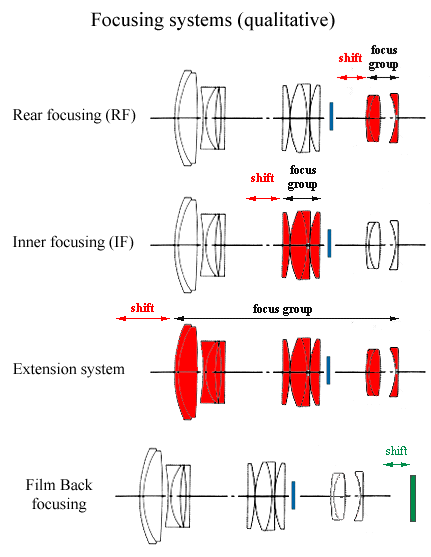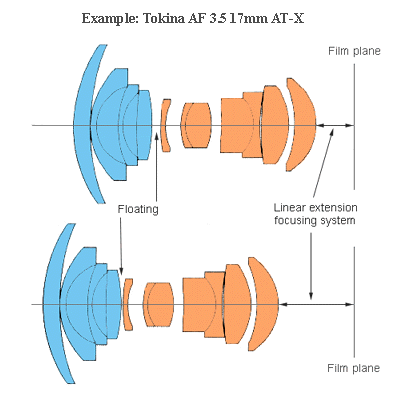|
Technology -
Technology
|
-
IF (internal/inner focusing)
One of the middle lens groups in front
of the diaphragm moves during focusing resulting in fast AF and light manual
focusing. No change in physical length of the lens body which also remains
quite small. Shorter minimum focus distances but often some decrease in
focal length towards closer focus distances. Non rotating front element.
-
RF (rear focusing)
Only one or more rear lens groups behind
the diaphragm move during focusing. Due to the small size and weight of
the group it enables faster AF. There may be a change in physical length
when zooming. A lens with a constant length and RF is in fact called an
IF lens. Non-rotating front element..
-
Extension system
All groups or the front group(s) are shifted
for focusing. The physical length changes usually during focusing and zooming
often combined with a rotating front element. Relatively slow AF with long
and heavy lenses. Relatively small max. magnifications (larger min. focusing
distance). In the case of an all-group shifting mechanism there's only
a relatively small increase of aberrations (=minor decrease of image quality).
-
Film back focusing
So far this type of focusing is used exclusively
in the Contax AX. In contrast to the other focusing systems there's no
need to shift heavy groups of glass but the film plane in the camera itself
is moved for focusing. The shifting distance is relatively small so the
focusing speed is potentially fast. The mechanical construction is quite
complicated (=expensive) and there're a couple of positive and negative
side effects. The most positive effect is the "increased" quality at closer
focus distances. All (manual) lenses can be set to infinity focus distance
(point of max. potential image quality). Furthermore the focusing system
can be used as an optional "extension tube" with increased close focus
capabilities. A certain drawback is the need to "pre-focus" long tele lenses
(300mm & up) off infinity because the shifting distance of the film
back does not reach out to provide focusing over the whole "normal" focusing
range.
 |
Floating Elements
On of the most underestimated effect on image
quality is the performance deterioration towards closer focus distances.
Curvature of field becomes significantly pronounced here and reduce the
sharpness towards the image borders. The same goes for large aperture lenses
that suffer from increased spherical aberrations here.
Normal lenses shift just a single group of elements for focusing. Additional
floating elements (see picture below) can improve the close-focus performance
significantly. However, the vast majority of all lenses does not feature
this mechanism. Even worse, many so-called "macro" lenses (e.g. 70-300macro,
400/5.6macro) don't have a floating system so don't expect good results
at critical magnifications (e.g. 1:4 or closer)! Many ultra-wide and virtually
all true macro lenses (e.g. 50/2.8macro, 100/2.8macro, 200/4macro) have
FEs though.
